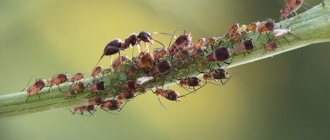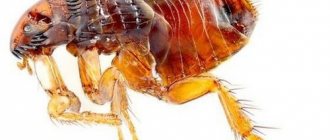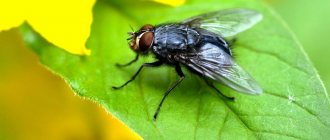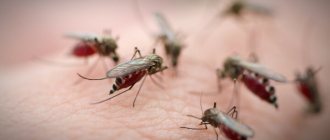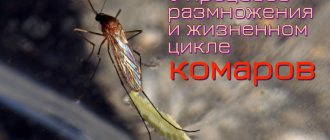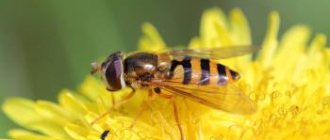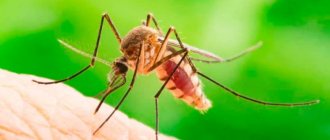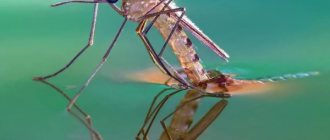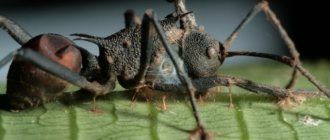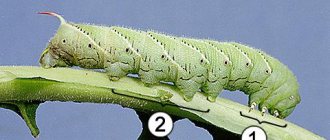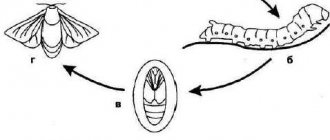Aphids on plants are a real disaster. Without exception, all gardeners and gardeners are familiar with this small insect, which poses a huge danger to the plants they grow. Due to its small size, it is difficult to notice immediately, and due to its large number, it is difficult to fight. It lives everywhere - on vegetable crops (potatoes, cabbage, etc.), on fruit trees (apple trees, etc.), on berry bushes (currants, gooseberries, etc.), and even on flowers (roses, etc.). All aphids feed on plant juices; many are capable of spreading diseases and dangerous viruses and causing abnormalities in plants such as galls (convex formations).
In this article about:
- what it is;
- Why is its number so gigantic?
- where does it come from on the site;
- what is its main danger;
- what to do to protect your plantings from this hated enemy.
General characteristics and appearance
Aphids are insects from the order Hemiptera. They have been known to science since the end of the 18th century; there are about 4 thousand species, almost a thousand live in Europe. The size of aphids does not exceed a few millimeters, although there are individual specimens measuring 5-7mm. All types of aphids have wingless (responsible for reproduction) and winged (responsible for spreading and changing plants) forms.
The appearance of aphids is very diverse (black, green, red, and even transparent). On the head are dark eyes and a pair of antennae. Winged forms of aphids have two pairs of transparent wings, with the back pair always shorter than the front. Aphids have a special proboscis with which they pierce leaves and young shoots.
The most common types:
- cherry aphid;
- potato;
- large cereal aphid;
- pea or bean;
- peach or tobacco;
- hop;
- phylloxera - grape aphid;
- apple green;
- leaf gall;
- cucumber melon;
- carrot;
- poplar;
- home or indoor, as well as many others.
Some of them are shown in the photo.
- Cabbage aphid
- Melon or cucumber
- Large cereal aphid
- house or house aphid
- Cherry aphid
- Pea or bean aphid
- Potato aphid
- Leaf gall aphid
- Phylloxera - grape aphid
Preventive measures
A greenhouse is a closed ecosystem and it is much easier to prevent a pest from appearing in it than to later fight aphids. Considering that in a confined space there is nowhere for it to come from, it becomes clear that it is brought in from the outside - during ventilation, opening doors, with new soil, seedlings or on your clothes.
It is difficult to block such a path of penetration, but it is still possible to resist infection. To do this in the greenhouse you must regularly:
- inspect the beds of cucumbers, tomatoes and peppers for the presence of aphids;
- remove plant debris: dead leaves, tops, roots;
- pay attention to weed control - they try to get rid of them as much as possible.
The set of measures includes treating the greenhouse using fumigation. A variety of checkers give good results: from tobacco to sulfur. You can buy it with insecticides in it. The smoke disinfects the soil and structural elements of the greenhouse and does not give any pest a chance. This control measure will be effective when used at the end and beginning of the season, as well as during the growing season.
Caustic soda or lime, when diluted in water, will help disinfect the contents of the greenhouse or equipment. Dilute in a proportion of 0.4-0.5 kg per 10 liters.
In cold regions, it is recommended to freeze greenhouses to combat aphids when critical temperatures occur in winter. To do this, they are simply left open for several days.
In addition, the list of recommendations for the prevention and control of aphids includes:
- Careful control of planting material. Purchased seedlings must be inspected for pests and undergo a quarantine period.
- Compliance with agricultural technology, namely planting dates, growing season, lighting regime, watering, fertilizing. Weak cucumbers or tomatoes that have suffered as a result of lack/excess of fertilizer or light will become easy prey for aphids. Moisten the soil only if necessary. In addition, never allow it to overflow when it gets cold.
- Control of temperature and air humidity. When growing the most popular cucumbers, tomatoes or peppers, the constant temperature should not go beyond the range of +18...+28°C, and the humidity should not be 75–90%.
- Prevent the appearance of ants and anthills. After detecting at least one, immediately inspect the entire greenhouse. Destroy them at the first threat.
There are interesting recommendations for maintaining paths in greenhouses. It is necessary to mulch them with a 5-7 cm layer of sawdust and lightly moisten them with a spray bottle. Bring in a few earwigs, then a strict aphid controller will simply settle in the greenhouse.
Growing early vegetables in a greenhouse is not the easiest job. Compared to open ground, tomatoes and cucumbers are still safer here. You just need to not miss the moment and take timely measures to combat aphids, or even better, prevent their appearance.
Life cycle and development features
In the spring, the egg hatches into a larva. The egg is laid by aphids on the host plant in the fall (in the roots of trees, in cracks in the bark, etc.). There are also overwintering larvae, for example, in phylloxera (grape aphids). The larva feeds on the sap of young shoots of the host plant in early spring and, after molting, begins parthenogenetic reproduction, producing only wingless females. In a month (April or May, depending on the region), up to three generations of insects with a total number of several hundred thousand individuals can appear from one wingless female.
Life cycle of aphids
After the young shoots become woody, winged females begin to be born, which begin migrating to neighboring plants of a certain species, spreading throughout the garden. During the summer, more than ten thousand generations of wingless and winged females appear. As a result, the total number of newly emerged insects amounts to trillions of individuals.
In autumn, nature provides for the birth of winged males, which fly to the host plant, where the females lay eggs for the winter.
Aphids lay eggs on plants, and some species of aphids are capable of viviparity. The generation of winged aphids is born of different sexes, and since they are responsible for migration, they travel long distances and create colonies in new places.
According to new research, the birth of winged aphids may also be caused by special aromatic substances that aphids secrete when they are attacked by enemies, such as ladybugs. These warning substances cause disturbance in the colony, which leads to the rapid production of winged aphid species. This is how the law of conservation of nature works.
Where do aphids overwinter and how to get rid of them once and for all?
Aphid infestation is a perennial problem for gardeners and gardeners. It would seem that she was destroyed, but the next year she appears again. Usually, the fight against this pest begins when it is visually clear what harm it has caused to the crop. The seasonality of such procedures is spring and summer. But even in winter, preventative measures can be taken that significantly help in the fight against the parasite.
Aphids on plants - distribution
Where do aphids come from in the garden? They originally came from their natural habitat, in which there are thousands of species. Subsequently, having settled in the garden plot, they began to live there on a permanent basis due to favorable conditions.
Most often, aphids enter cultivated areas with new plants that have not been checked for infestation. Aphids on plants can colonize from untidy neighboring areas.
Symbiosis of aphids and ants
In addition, ants also help aphids to settle - a typical symbiosis between aphids and ants. Ants “graze” aphids and receive from them in return a sweet treat - honeydew (excretion containing sugar). Ants help preserve and protect aphids from predators and parasites. They can even transfer them to other plants, and in winter they place it in their anthill.
Use of chemicals
Manufacturers offer a huge number of chemicals that help fight aphids that have occupied vegetable or garden crops:
- Karbofos (Malathion) is an effective remedy with which you can quickly get rid of not only aphids, but also flies, fleas, mosquitoes, ants, bedbugs and cockroaches. In stores, this drug is provided by the drug “Fufanon”. The bottle contains 10 ml of the substance, which must be diluted in water (10 l) before treatment.
- Aktara (Thiamethoxam) is a broad-spectrum drug. With its help you can get rid of aphids and ants for a long time.
- Intavir - effectively fights aphids. Available in tablet form. The consumption rate of the drug is 1 tablet per 0.6 liters of water. Since Intavir has a nerve-paralytic effect on insects, the result can be seen within 20-25 minutes. after processing.
Risk factors. What is the main danger?
The damage caused by aphids is quite great. Colonies are located on the lower surface of the leaves and cannot be recognized immediately. During their life, aphids release toxins that lead to changes in the shape of plant organs. This is especially noticeable on young leaves and shoots.
The leaves curl, the buds fall off before they have time to open, and the fruits do not set. Spots or pigment mesh may appear on the leaves. Blistering and swelling on the leaves may be observed - this is the formation of galls, which over time become ulcers. A grayish coating may be observed on the leaves, this is a consequence of infection with a fungus. On top of all this, the leaves become sticky and sticky due to the honeydew secreted.
If there is a massive infestation of aphids, plant growth can be completely stopped. Weakened, diseased plants, or parts of plants, cannot withstand wintering and die.
Risk factors caused by aphid infestation of plants
In addition to all of the above, some types of aphids carry incurable viruses that infect plants. In this case, it is simply impossible to save an apple tree or currant bush; it needs to be dug up by the roots and disposed of.
Detection
Take a close look at your plants, every single one of them. If numerous colonies of point pests and sticky liquid (honeydew) are visible on the back of the leaves, buds, or shoots, and the old skin of the insects remains in white pieces, then this is a real aphid infestation.
But don't despair! When pests appear in the greenhouse, immediately start a war with them - use folk remedies, such as mechanical, environmental (biological) and chemical.
Protection and prevention measures
There are several ways to protect plants from aphids - agrotechnical, biological, mechanical and chemical. In a separate article we will dwell in detail on each of them. Let us outline general recommendations on how to protect plants from aphids.
1. Natural enemies. Nature itself provided for everything when conceiving the “food chain” scheme. Natural enemies of aphids include some insects and songbirds. Birds are attracted to the site by feeders and plantings of berry bushes. Insects that feed on aphids include ladybugs, wasps, lacewings, hoverflies, some types of ichneumon beetles, mantises, ground beetles, earwigs and many others. You can breed some types of beneficial insects yourself—ladybird and lacewing eggs can be ordered online or at garden centers.
2. Insecticidal agents . A separate material on the site covers this topic in detail, “Comparative analysis of the TOP 10 best insecticides for aphids . Recommendations for the use of chemical plant protection products are offered (composition, active ingredient, dosage, regulations for use, safety and restrictions, etc.)
3. Planting plants that attract beneficial insects. These include spicy plants (mint, fennel, oregano, dill) and those with a bright smell that repel aphids (garlic, calendula, lavender, clover, etc.). In addition, you should know those plants that attract aphids (poppy, nasturtium, cosmos, mallow, begonia, linden, viburnum, apple tree).
4. “Folk methods” of fighting aphids are diverse, they are used often and quite effectively. These include the use of:
- laundry and green soap;
- wood ash;
- soda and tobacco (tobacco and/or tobacco dust);
- iodine and milk;
- ammonia and ammonia;
- vinegar (vinegar essence);
- potato and tomato tops;
- celandine;
- sulfur/colloidal sulfur;
- garlic and onion peels;
- tar and many, many others. I will also talk about them in detail in a separate material on the site .
Means for fighting
There are many ways to control aphids, including both biological and chemical. First, you should always use folk remedies and advice, since they are safer for humans, the environment, and the plant itself. When using them, there is no need to wait time before harvesting. Folk remedies:
- Mechanical washing of insects from plants with water from a hose.
- Spraying plants with soap solution. Dissolve 100 g of tar soap in 10 liters of warm water.
- Treatment of crops with infusion of ash. Dilute a glass of ash in 5 liters of water and leave for 12 hours.
- Spraying with tobacco infusion. Pour a glass of shag, tobacco or cigarette butts into 5 liters of boiling water, leave for 24 hours, strain, and spray the affected plants.
- Spicy infusion. Prepared with hot pepper, horseradish and garlic. 1 pod of pepper, 1 horseradish root, a couple of its leaves, a couple of cloves of garlic, cut everything into pieces, pour 1 liter of boiling water, leave for 24 hours. You can use one ingredient, then you need to take 2 times more of it.
- Pine infusion, pour 1 kg of pine needles into 4 liters of boiling water, leave for a week, stir daily. Before processing, dilute the infusion with water in a 50/50 ratio.
All events are best held in the evening. The crop must be sprayed generously so that the solution flows onto the back surface of the leaves, where the pest mainly accumulates. On average, 2-3 procedures are needed to completely destroy aphids.
Chemicals are reserve drugs when no folk remedies can cope with this pest. Chemical solutions can have a detrimental effect on young shoots, and aphids feed on the juice of young plants, since they cannot pierce the skin of ripe ones, so you should not abuse these products. More often they try to use 2 types of agents, which belong to the group of intestinal and contact. The former affect the digestive system of the parasite, it dies of hunger, and the latter immediately affect the insect. More gentle chemicals include: “Strela”, “Biotlin”. To strong solutions that penetrate the plant: “Intavir”, “Aktara”, “Iskra”. After using such solutions, you can eat or harvest after 25-35 days.
Additional preventative measures for pest control include planting repellent plants in areas: marigolds, mint, calendula, chamomile, garlic, onions. Attracting birds and insects that feed on aphids. To lure birds, it is worth hanging up feeders and drinkers, and for insects, it is enough to plant herbs and carrots.
Aphids are a well-known parasite for gardeners. It often affects various cultures, but it is precisely because of its “popularity” that there are so many means and drugs to combat it. If you constantly use preventive measures, you can achieve the disappearance of this insect from the site.
